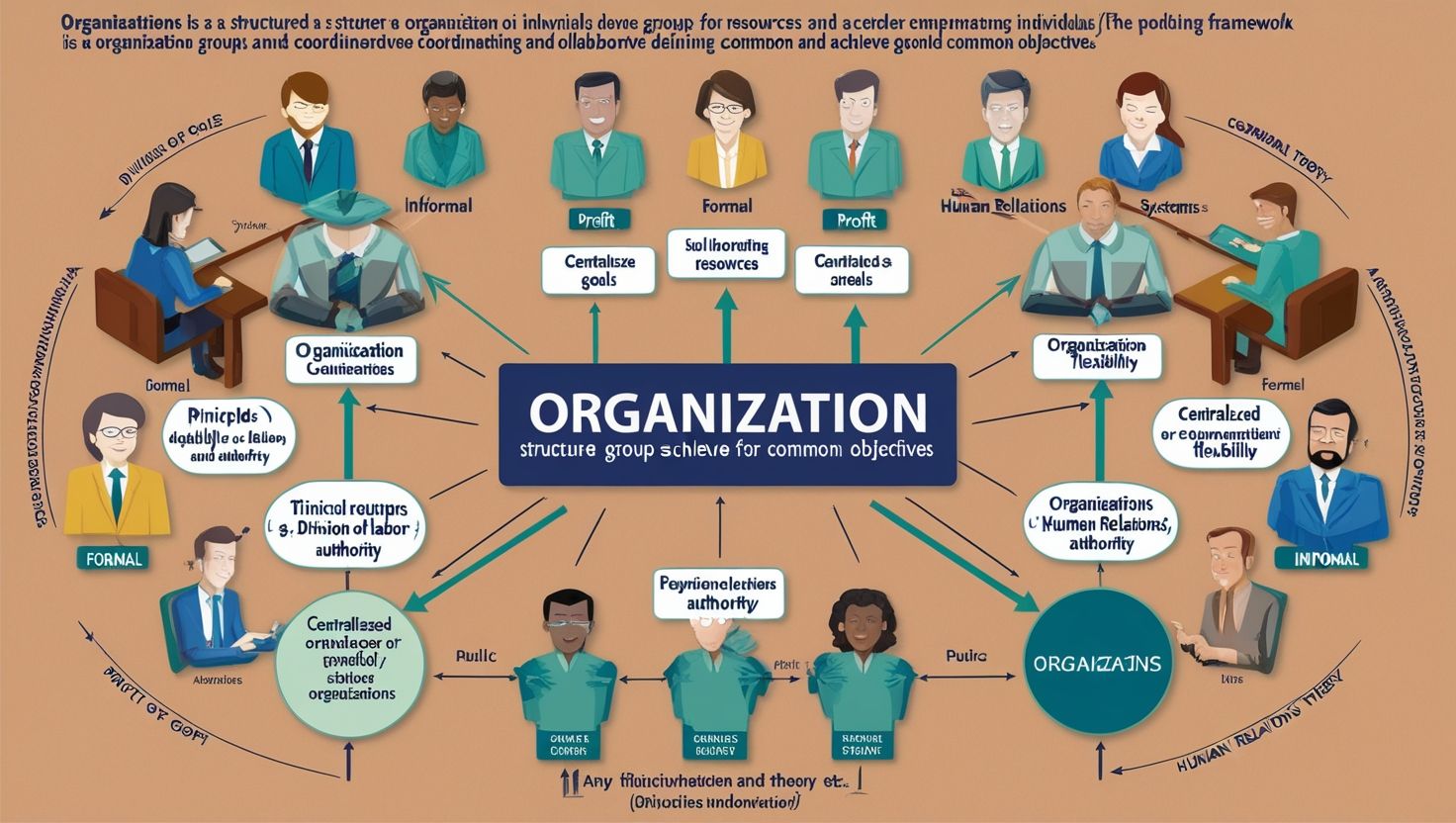Definition and Importance
An organization is a structured system of individuals working together to achieve common objectives. It forms the backbone of all societal, economic, and political activities. Whether in the private, public, or non-profit sectors, organizations bring order, allocate resources efficiently, and foster collaboration. Understanding the types, theories, principles, and specific structures—such as federal and provincial governments and public sector enterprises—is essential for effective management and governance.
Types of Organization
Organizations can be broadly classified into the following categories:
- Formal Organizations
These are established with specific goals and a defined structure. Examples include corporations, government bodies, and educational institutions. - Informal Organizations
These emerge spontaneously through interpersonal relationships and social interactions. They lack rigid structures and are often found within or alongside formal organizations. - Profit and Non-Profit Organizations
- Profit organizations aim to generate revenue, such as businesses and corporations.
- Non-profit organizations focus on social causes or services, like charities and NGOs.
- Public and Private Organizations
- Public organizations are government-controlled entities focused on public welfare.
- Private organizations operate under private ownership, aiming at profit or service.
- Centralized and Decentralized Organizations
- Centralized organizations concentrate decision-making power at the top level.
- Decentralized organizations delegate authority across various levels for flexibility and innovation.
Theory of Organization
Organizational theory explores how organizations function, develop, and interact with their environments. Key theories include:
- Classical Theory
Focused on efficiency and hierarchy, this theory emphasizes clear roles, centralized authority, and strict discipline.- Key proponents: Frederick Taylor (Scientific Management), Henri Fayol (Administrative Theory).
- Human Relations Theory
Stresses the importance of interpersonal relationships and employee satisfaction.- Key proponent: Elton Mayo (Hawthorne Studies).
- Systems Theory
Views organizations as open systems interacting with their environments, emphasizing adaptability and feedback loops. - Contingency Theory
Suggests that no single organizational structure is universally effective; effectiveness depends on environmental and situational factors. - Modern and Postmodern Theories
Focus on dynamic, networked, and flexible structures suitable for a rapidly changing world. Concepts like knowledge management and learning organizations fall under this category.
Principles of Organization
Certain foundational principles guide the design and functioning of organizations:
- Division of Labor
Specialization enhances efficiency and expertise by assigning specific tasks to individuals or groups. - Authority and Responsibility
Clear lines of authority ensure accountability, while responsibility aligns with authority to prevent power misuse. - Unity of Command
Employees should receive orders from only one superior to avoid confusion and conflict. - Scalar Chain
A well-defined hierarchy ensures smooth communication and decision-making. - Span of Control
Refers to the optimal number of subordinates a manager can effectively oversee. - Coordination
Integration of efforts across various departments or teams ensures alignment with organizational goals. - Flexibility
Organizations should adapt to environmental changes while maintaining core structures and values.

Organization of the Federal and Provincial Governments
Governmental organization reflects the distribution of power and responsibilities across various levels:
- Federal Government Organization
The federal government operates at the national level, managing areas like defense, foreign policy, and macroeconomic planning.- Key institutions include the legislature (parliament), executive (president/prime minister and cabinet), and judiciary.
- Provincial Government Organization
Provincial governments handle region-specific matters such as education, health, and local infrastructure.- Institutions mirror the federal structure but function within the scope defined by the federal constitution.
- Inter-Governmental Coordination
Effective collaboration between federal and provincial entities is essential for cohesive policymaking and resource allocation.
Public Sector Enterprises
Public sector enterprises (PSEs) are government-owned organizations established to serve economic and social objectives. They operate in sectors deemed critical for national development, such as energy, transportation, and finance.
- Roles and Objectives
- Provide essential services to the public.
- Stimulate economic growth in underdeveloped regions.
- Generate employment opportunities.
- Ensure equitable distribution of resources.
- Types of Public Sector Enterprises
- Departmental Enterprises: Operate directly under government ministries (e.g., postal services).
- Statutory Corporations: Established through legislative acts with operational autonomy (e.g., central banks).
- Government Companies: Registered under company law but majority-owned by the government.
- Challenges
- Inefficiency and bureaucracy.
- Financial losses due to mismanagement.
- Political interference in operations.
- Reforms and Privatization
Many governments have initiated reforms to improve PSE efficiency, including partial or full privatization.
Conclusion
Organizations are pivotal in shaping society, driving economies, and ensuring governance. By understanding their types, theories, and principles, as well as their role in federal and provincial governance and public sector enterprises, stakeholders can foster more effective and adaptive structures. In a rapidly evolving world, the ability to innovate and align organizational practices with societal needs remains a cornerstone of progress.

0h4glj
I truly appreciate this post. I have been looking all over for this! Thank goodness I found it on Bing. You have made my day! Thanks again
44qw97
bs2uh8
Hey! This is my first visit to your blog! We are a group of volunteers and starting a new initiative in a community in the same niche. Your blog provided us beneficial information to work on. You have done a extraordinary job!
Wohh precisely what I was looking for, appreciate it for posting.
Thanks for another excellent post. Where else could anybody get that kind of info in such an ideal way of writing? I have a presentation next week, and I am on the look for such info.
Thank you for any other informative web site. Where else may I am getting that kind of info written in such a perfect means? I’ve a mission that I’m simply now working on, and I have been on the glance out for such info.
very good put up, i actually love this website, carry on it
I’ve learn a few excellent stuff here. Definitely worth bookmarking for revisiting. I surprise how a lot attempt you place to create this sort of fantastic informative web site.
I don’t even know how I ended up here, but I thought this post was good. I don’t know who you are but certainly you are going to a famous blogger if you aren’t already 😉 Cheers!
You can certainly see your expertise within the paintings you write. The sector hopes for even more passionate writers such as you who aren’t afraid to mention how they believe. Always go after your heart.
Awsome info and right to the point. I don’t know if this is truly the best place to ask but do you people have any ideea where to employ some professional writers? Thanks in advance 🙂
Does your blog have a contact page? I’m having trouble locating it but, I’d like to send you an email. I’ve got some creative ideas for your blog you might be interested in hearing. Either way, great website and I look forward to seeing it improve over time.
You are my intake, I possess few web logs and very sporadically run out from to post : (.
Hi there, You have done a great job. I’ll definitely digg it and personally recommend to my friends. I’m confident they will be benefited from this website.
Hiya! Quick question that’s entirely off topic. Do you know how to make your site mobile friendly? My web site looks weird when browsing from my iphone 4. I’m trying to find a template or plugin that might be able to correct this problem. If you have any recommendations, please share. Thank you!
Thanx for the effort, keep up the good work Great work, I am going to start a small Blog Engine course work using your site I hope you enjoy blogging with the popular BlogEngine.net.Thethoughts you express are really awesome. Hope you will right some more posts.
My programmer is trying to persuade me to move to .net from PHP. I have always disliked the idea because of the costs. But he’s tryiong none the less. I’ve been using WordPress on numerous websites for about a year and am anxious about switching to another platform. I have heard great things about blogengine.net. Is there a way I can transfer all my wordpress content into it? Any kind of help would be greatly appreciated!